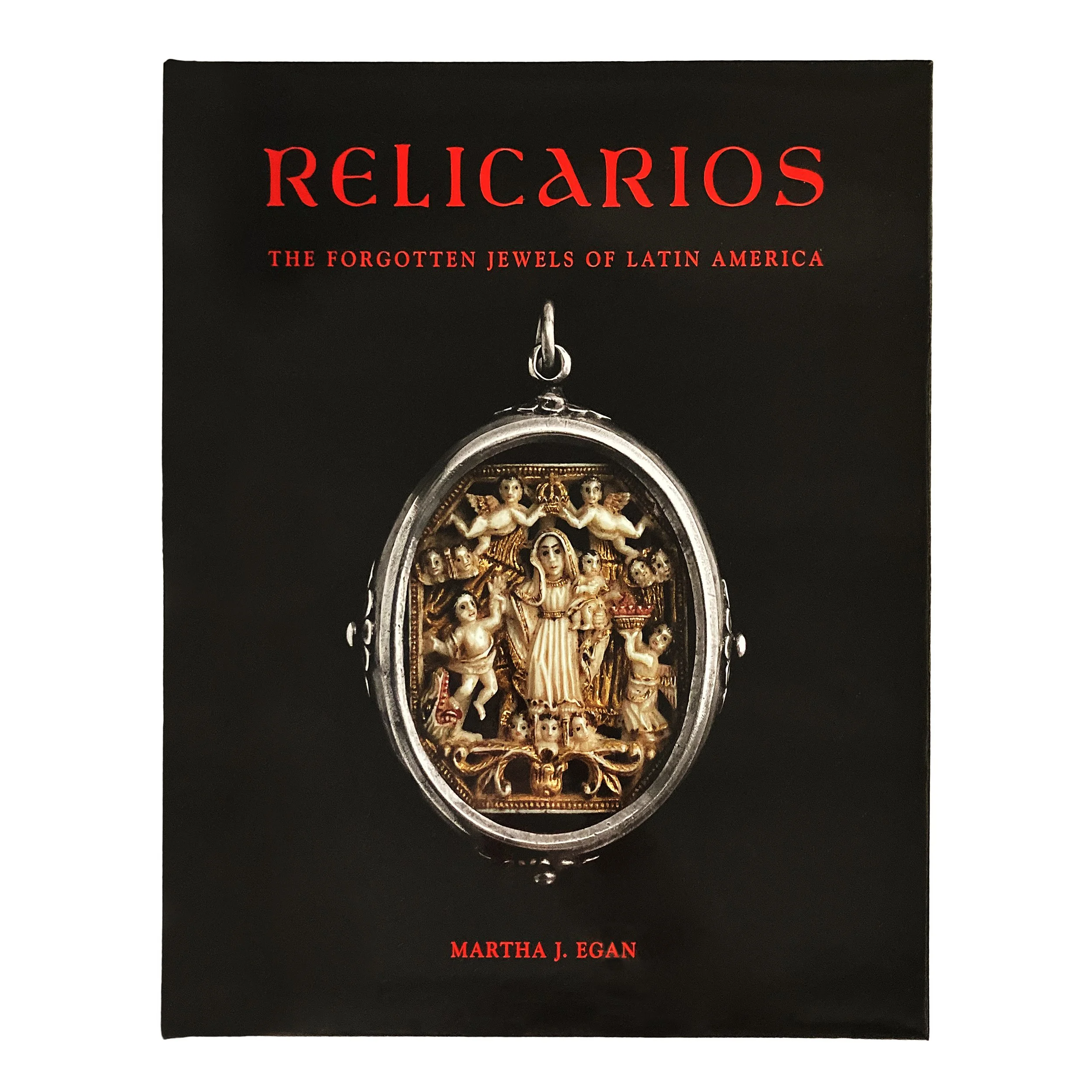 Image 1 of 4
Image 1 of 4

 Image 2 of 4
Image 2 of 4

 Image 3 of 4
Image 3 of 4

 Image 4 of 4
Image 4 of 4





Relicarios: The Forgotten Jewels of Latin American by Martha Egan
Relicarios--finely crafted, bi-faced lockets of gold or silver--are artifacts of the Spanish Colonial era. These exquisite jewels containing devotional imagery protected by glass may include paintings on vellum, nacre, alabaster, copper, or ivory; prints; or miniature sculptures of boxwood, ivory, alabaster, or tagua. Although tons of relics were imported from Europe, particularly by Jesuits, in general only high-status individuals wore relicarios containing relics.
Relicarios attest to colonists' dedication to their favorite Virgins and saints as well as fealty to church and crown. As powerful amulets they protected wearers in a precarious world. Relicarios reflects forty years of the author’s research, including correspondence and interviews with relicarieros, art historians, curators, collectors, silversmiths, anticuarios, and clergy as well as the author's collection of several hundred examples. Photos commissioned from leading art photographers in the Americas were mostly unpublished until this handsome volume.
Author Martha J. Egan's background includes a BA in Latin American history from the University of the Americas in Mexico City as well as a half-century of studies in what her Jesuit mentor called La Universidad de la Calle, the University of the Street. Her experiences of living in Mexico as a student and in Venezuela as a Peace Corps volunteer as well as four decades of buying and selling Latin American folk art and Spanish Colonial art through her business, Pachamama, have served as an informal and invaluable education for Egan. She is a research associate at the Museum of International Folk Art; a frequent speaker at museums and universities; and the author of two nonfiction books, four award-winning works of fiction, and articles published in Argentina, Great Britain, Mexico, Spain, Portugal, and the United States. She lives in rural New Mexico with the ghost of an old cat.
Relicarios--finely crafted, bi-faced lockets of gold or silver--are artifacts of the Spanish Colonial era. These exquisite jewels containing devotional imagery protected by glass may include paintings on vellum, nacre, alabaster, copper, or ivory; prints; or miniature sculptures of boxwood, ivory, alabaster, or tagua. Although tons of relics were imported from Europe, particularly by Jesuits, in general only high-status individuals wore relicarios containing relics.
Relicarios attest to colonists' dedication to their favorite Virgins and saints as well as fealty to church and crown. As powerful amulets they protected wearers in a precarious world. Relicarios reflects forty years of the author’s research, including correspondence and interviews with relicarieros, art historians, curators, collectors, silversmiths, anticuarios, and clergy as well as the author's collection of several hundred examples. Photos commissioned from leading art photographers in the Americas were mostly unpublished until this handsome volume.
Author Martha J. Egan's background includes a BA in Latin American history from the University of the Americas in Mexico City as well as a half-century of studies in what her Jesuit mentor called La Universidad de la Calle, the University of the Street. Her experiences of living in Mexico as a student and in Venezuela as a Peace Corps volunteer as well as four decades of buying and selling Latin American folk art and Spanish Colonial art through her business, Pachamama, have served as an informal and invaluable education for Egan. She is a research associate at the Museum of International Folk Art; a frequent speaker at museums and universities; and the author of two nonfiction books, four award-winning works of fiction, and articles published in Argentina, Great Britain, Mexico, Spain, Portugal, and the United States. She lives in rural New Mexico with the ghost of an old cat.
Relicarios--finely crafted, bi-faced lockets of gold or silver--are artifacts of the Spanish Colonial era. These exquisite jewels containing devotional imagery protected by glass may include paintings on vellum, nacre, alabaster, copper, or ivory; prints; or miniature sculptures of boxwood, ivory, alabaster, or tagua. Although tons of relics were imported from Europe, particularly by Jesuits, in general only high-status individuals wore relicarios containing relics.
Relicarios attest to colonists' dedication to their favorite Virgins and saints as well as fealty to church and crown. As powerful amulets they protected wearers in a precarious world. Relicarios reflects forty years of the author’s research, including correspondence and interviews with relicarieros, art historians, curators, collectors, silversmiths, anticuarios, and clergy as well as the author's collection of several hundred examples. Photos commissioned from leading art photographers in the Americas were mostly unpublished until this handsome volume.
Author Martha J. Egan's background includes a BA in Latin American history from the University of the Americas in Mexico City as well as a half-century of studies in what her Jesuit mentor called La Universidad de la Calle, the University of the Street. Her experiences of living in Mexico as a student and in Venezuela as a Peace Corps volunteer as well as four decades of buying and selling Latin American folk art and Spanish Colonial art through her business, Pachamama, have served as an informal and invaluable education for Egan. She is a research associate at the Museum of International Folk Art; a frequent speaker at museums and universities; and the author of two nonfiction books, four award-winning works of fiction, and articles published in Argentina, Great Britain, Mexico, Spain, Portugal, and the United States. She lives in rural New Mexico with the ghost of an old cat.
